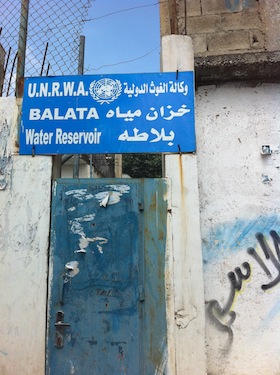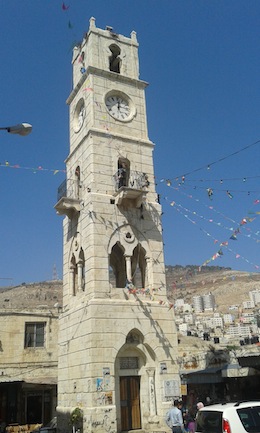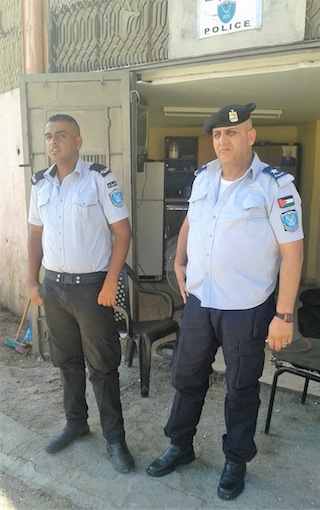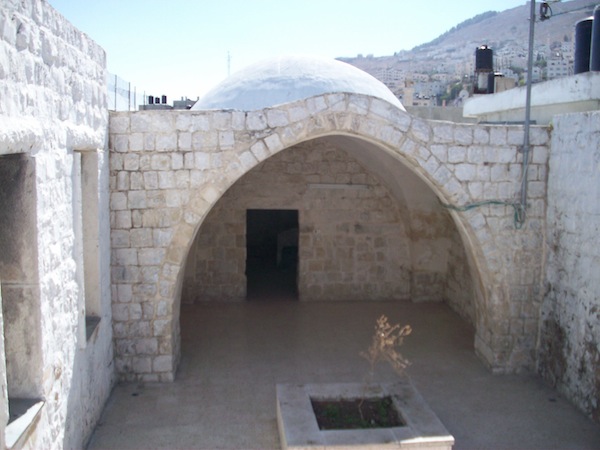Joseph’s Tomb, inside the gate. (photo by Gil Zohar)
“The bones of Joseph, which the Children of Israel brought up from Egypt, were buried in Shechem in the portion of the field that had been purchased by Jacob.” – Joshua 24:32
“‘And he bought the field where he pitched his tent.’ (Genesis 13:19) Said Rav Yudan bar Simon, ‘This is one of the three places regarding which the nations of the world cannot slander Israel and say, “You stole them!” The places are the Cave of Machpelah [in Hebron], the Temple [in Jerusalem] and the Tomb of Joseph [in Shechem/Nablus].” – Bereshit Rabba, 79:4
There’s little inspiration to be found in the unadorned tomb of Joseph, the favourite of Jacob’s 12 sons. The holy site, located in the gritty eastern outskirts of Nablus among parched olive groves and graveyards of wrecked cars, is today a flashpoint between those who revere the site – Israeli Jews, Palestinian Muslims, Christians of all stripes, and the 600-member Samaritan community living on Mount Gerizim overlooking this West Bank city of 160,000. The traditional anniversary of Joseph’s death on Tammuz 27 (which fell on July 31 this year) is considered an especially auspicious pilgrimage time.
The group of 1,200 pious Jews, armed with permits and prayer books, arrived at the shrine in a convoy of bulletproof buses protected by the Israel Defence Forces. Most were Bratslaver Chassidim, who set great store in their practice of praying at the graves of tzadikim (righteous ones).
The IDF-escorted pilgrimage on the first Tuesday of every month often leads to riots. IDF sappers neutralized a pipe bomb hidden at Joseph’s Tomb prior to the visit of the 1,200 pilgrims and 12 Palestinians were injured during clashes with the IDF. The list of security incidents, arson and terrorism is long and bloody.
In the secular West, the story of Joseph – whose 11 jealous brothers sold their 17-year-old sibling into slavery in Egypt – has been popularized by the rock opera Joseph and the Amazing Technicolor Dreamcoat. Librettist Tim Rice and fellow Academy Award-winning composer Andrew Lloyd Weber, along with actor Donny Osmond as Joseph, captivated audiences from Broadway to the West End with their account of Joseph’s rise to become the vizier, second only to Pharaoh in the Egyptian empire.
But Joseph, the hero of Bible and Quran stories, has hardly been given the royal treatment by Middle East politics. Dotan, where Joseph was thrown into a pit, called Jubb Yussef (Joseph’s Well) today is a ruined caravanserai that collapsed in an earthquake in 1837. Joseph’s tomb, enshrining the bones brought back from Egypt by the Children of Israel some 3,300 years ago together with the remains of Joseph’s sons Ephraim and Manasseh, has fared better.
The plain one-storey is called Qabr an-Nabi Yúsuf (Tomb of the Prophet Yúsuf) in Arabic and is revered by Jews as Kever Yosef ha-Tzadik (Tomb of Yosef the Righteous). The whitewashed limestone building is capped with a cupula and protected by a massive black gate. Barbed wire crowns the looming walls. Signposts in Arabic and English indicate the nearby sites of Tel Balata and Jacob’s Well. None directs visitors to Joseph’s Tomb.

Tel Balata is the nondescript Canaanite/Israelite Iron Age stratified archeological mound that few tourists bother to visit. Jacob’s Well is covered by a 20th-century Greek Orthodox basilica marking where the patriarch camped when returning to Shechem (ancient Nablus) from Paddan Aram in today’s Iraq. In one of the Torah’s three real estate deals – along with Abraham’s purchase of the Cave of Machpelah in Hebron and David’s acquiring of Mount Moriah in Jerusalem – Jacob bought the plot of land from the sons of Hamor, the father of Shechem. There, Jacob pitched his tent and erected an altar (Genesis 33:18-20).
Some 1,500 years later, Jesus “came to a city of Samaria called Sychar, near the field which Jacob gave to his son Joseph. Jacob’s Well was there.” (John 4:5-10) Drinking water, he chatted up a Samaritan woman, known in Greek as Photine (the luminous one; hence, the church’s name, St. Photini). Christian pilgrims flock to the site to reverently drink drafts of cool water from the deep well in the church’s vault.
Across the street is Balata Refugee Camp, administered by the United Nations Relief and Works Agency for Palestine Refugees in the Near East (UNRWA). Today the largest camp in the West Bank, it houses 27,000 people in a quarter-square-kilometre site that was designated for 5,000 refugees when it was established in 1950.

Even for an intrepid, multilingual tour guide like this writer, it is daunting to find the unmarked way to the holy site. The drab building is located next to the Qadari Tuqan School, along a dusty unnamed road where only recently were sidewalks laid. The easiest way to find the landmark is to look for the Palestinian Authority police vehicle parked outside the locked gate. Then, one must locate the pair of PA police officers loitering in the shade nearby, smoking cigarettes and nervously fidgeting with their rifles. Ask politely in Arabic and they’ll let you in, no questions asked, no baksheesh (tip or bribe) required – just don’t mention that you’re Jewish.
Inside the locked gate, you’ll find a simple barrel tomb and the stump of a column of indeterminate age. There’s no evidence of the repeated vandalism that has punctuated the tragic history of Joseph’s Tomb since 1995, when Israel withdrew from the West Bank city, ending the occupation that began in 1967 with the Six Day War.
A photo from 1900 shows the well-maintained compound around Joseph’s Tomb. A carriage road facilitated the pilgrimage of pious Jews from the Old Yishuv who regularly came to pray there. The holy site stood in isolation. Nearby was the Arab hamlet of Balata, with eight houses.
The name Nablus is a corruption of the Latin Colonia Julia Neapolis, which was founded by the Roman emperor Vespasian in 72 CE. In the old city, in 1906, Ottoman Sultan Abdul Hamid II erected a clocktower to celebrate 30 years on the throne of the Sublime Porte.
In the Six Day War, Israel captured the territory, which had been occupied by the Hashemite Kingdom of Jordan since 1948. Once-somnolent Nablus experienced a burst of prosperity, though today, under PA self-rule, the Palestinian economy is floundering. Expanding from a population of 30,000, the city spread out to swallow the nearby villages, including Balata. Joseph’s Tomb became entangled in urban sprawl.
Jewish settlers began to frequent the mausoleum. By 1975, Muslims were prohibited from visiting the site, which some claimed was the tomb of Sheikh Yúsuf Dawiqat, an 18th-century Sufi saint. In 1982, St. Louis, Mo.-born kabbalist Rabbi Yitzchak Ginsburgh established the Od Yosef Chai (Joseph Still Lives) yeshivah at the site.

Conflict mounted following the Oslo Accords. Tensions boiled over in September 2000, in the wake of then-prime minister Ariel Sharon’s controversial visit to Jerusalem’s Temple Mount. A full-scale battle broke out.
On Oct. 1, 2000, Border Police Cpl. Madhat Yusuf, 19, of Beit Jann in the Upper Galilee, was wounded in the neck in a clash with Palestinians at Joseph’s Tomb. Over the course of four hours, the Druze warrior bled to death because the IDF considered it too risky to evacuate him without a ceasefire.
A week later, on Oct. 7, 2000, the site was handed over to PA police. Within hours, Joseph’s Tomb was pillaged by Palestinian protesters. Using pickaxes, sledgehammers and their bare hands, they demolished the holy site. It was rebuilt by Italian stonemasons.
In the Bible, Joseph – the chaste and handsome prisoner – is wooed by an unnamed would-be lover only identified as Potiphar’s wife. Though many midrashim about Joseph are incorporated in the Quran’s 12th chapter, known as Surat Yusuf, the lady’s name is similarly omitted. However, within several centuries, various Islamic sources identified her as Zuleika. Among these medieval texts, the most popular was the epic Farsi poem “Yusuf and Zulaikha,” composed in 7,000 Persian couplets by 15th-century poet Jami.
The Sufi master regarded the story of Joseph’s temptations as an allegory for the mystical striving after divinity. In Nablus today, pilgrims continue to come to Joseph’s Tomb seeking that union. Alas, Israelis and Palestinians have not found a coat of many cultures to fit them both equally.
Gil Zohar is a writer and tour guide in Jerusalem, Israel.

